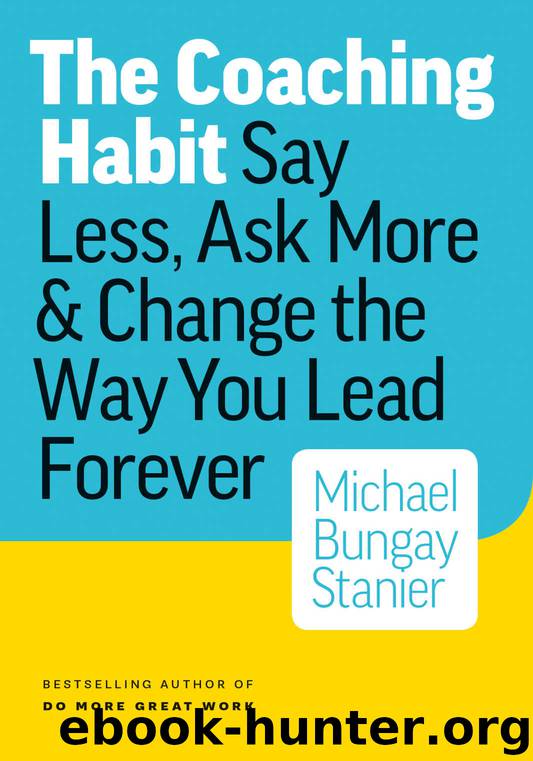The Coaching Habit: Say Less, Ask More & Change the Way You Lead Forever by Michael Bungay Stanier

Author:Michael Bungay Stanier
Language: eng
Format: mobi
Publisher: Box of Crayons Press
Published: 2016-02-28T14:00:00+00:00
AFFECTION CREATION RECREATION
FREEDOM IDENTITY UNDERSTANDING
PARTICIPATION PROTECTION SUBSISTENCE
When you ask someone, “What do you want?” listen to see if you can guess the need that likely lies behind the person’s request. For example, when someone says, “I want you to talk to the VP for me,” he might really be needing protection (I’m too junior) or participation (I need you to do your part in this project). When someone tells you, “I want to leave early today,” she might really be asking for understanding (it’s difficult at home) or creation (I need to go to my class). When someone says, “I want you to do a new version of the report,” the base need might be freedom (I don’t want to do it), identity (I want you to know I’m the boss here) or subsistence (my success depends on your getting this right.)
You can see that recognizing the need gives you a better understanding of how you might best address the want. And there’s a flip side to that as well. As you frame your own request for what you want, see if you can articulate what the need is behind the request.
Ask a Question. Trade Answers.
I was not a successful law student. I remember almost nothing from my classes, and I ended my studies by being sued by one of my lecturers for defamation. It’s a long story.
But one thing that has stuck in my brain is that the essence of a legal contract is an exchange of value. It turns out that this principle can help you build more resilient and mutually beneficial relationships with the people with whom you work.
There are times when simply asking a question is the thing to do. And there are other times when sharing your answer to that same question can increase its impact. “What do you want?” is an extraordinarily strong question. Its power is amplified when you not only ask the question of the person you’re working with but also answer the question for yourself. It takes us back to Peter Block’s point, mentioned at the start of the chapter, about the nature of adult-to-adult conversations. When we each understand what the other wants, we’re in the middle of an interesting and worthwhile conversation. And part of the reason for that is the neuroscience of engagement.
Our New Frontier: The Neuroscience of Engagement
As we tap into our twenty-first-century laptops, one click on Google Earth shows that there’s not a whole lot of terra incognito left. You can visit any country you want, and a few intrepid people have even visited all 195.
But there are still new frontiers of knowledge to be explored, and one of the most exciting is neuroscience, the study of the brain. Using creative experiments and sophisticated technology, such as fMRI and EEG machines, we’re starting to see that the art of leadership has its basis in science. We can now begin to see what really works and what doesn’t work in our attempts to engage with those we manage and influence.
Download
This site does not store any files on its server. We only index and link to content provided by other sites. Please contact the content providers to delete copyright contents if any and email us, we'll remove relevant links or contents immediately.
Hit Refresh by Satya Nadella(8864)
The Compound Effect by Darren Hardy(8524)
Change Your Questions, Change Your Life by Marilee Adams(7384)
Nudge - Improving Decisions about Health, Wealth, and Happiness by Thaler Sunstein(7260)
The Black Swan by Nassim Nicholas Taleb(6782)
Deep Work by Cal Newport(6578)
Daring Greatly by Brene Brown(6230)
Rich Dad Poor Dad by Robert T. Kiyosaki(6191)
Principles: Life and Work by Ray Dalio(5983)
Man-made Catastrophes and Risk Information Concealment by Dmitry Chernov & Didier Sornette(5664)
Playing to Win_ How Strategy Really Works by A.G. Lafley & Roger L. Martin(5528)
Digital Minimalism by Cal Newport;(5396)
Big Magic: Creative Living Beyond Fear by Elizabeth Gilbert(5360)
The Myth of the Strong Leader by Archie Brown(5244)
The Slight Edge by Jeff Olson(5203)
Discipline Equals Freedom by Jocko Willink(5160)
The Motivation Myth by Jeff Haden(5010)
Stone's Rules by Roger Stone(4867)
The Laws of Human Nature by Robert Greene(4790)
